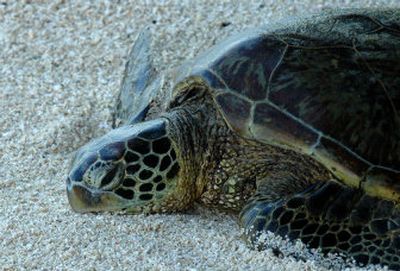Marine sanctuary will be largest

WASHINGTON – President Bush plans today to designate a marine sanctuary spanning nearly 1,400 miles of the Pacific Ocean northwest of Hawaii to Midway Atoll, creating the largest protected marine reserve in the world, according to sources familiar with the plan.
Establishing the Northwestern Hawaiian Islands as the nation’s 14th marine sanctuary could prove to be the administration’s most enduring environmental legacy. The roughly 100-mile-wide area encompasses a string of uninhabited islands that support more than 7,000 marine species, at least a fourth of which are found nowhere else.
The islands include almost 70 percent of the nation’s tropical, shallow-water coral reefs, a rookery for 14 million seabirds, and the last refuge for the endangered Hawaiian monk seal and threatened green sea turtle. The area also has an abundance of large predatory fish at a time when 90 percent of such species have disappeared from the world’s oceans.
Encompassing nearly 140,000 square miles, an area nearly the size of Montana and larger than all the national parks combined, the reserve would just surpass Australia’s Great Barrier Reef Marine Park as the largest sanctuary in the world. It would also, however, be one of the least accessible.
“This is a landmark conservation event,” said Joshua Reichert, who heads the Pew Charitable Trust’s environment program, which had pushed for the designation. “The government is saying in certain places, for certain reasons, it is important to restrict activities that have the potential to damage the marine environment, of which fishing is a big one.”
The plan had been resisted by local Hawaiian fishing interests who feared losing access to traditional fishing grounds.
The nation’s existing 13 marine sanctuaries, which are sprinkled from the Florida Keys to the Channel Islands off the California coast, impose varying levels of protection and have had mixed success in protecting sensitive ecosystems.
Administration officials declined to comment on the record, but one senior official, who requested anonymity in order not to upstage the president’s announcement, said the plan would end fishing in the area within five years. It would allow Hawaiians to have access for other traditional activities and keep the Midway World War II memorial open for research, education and ecotourism. Visitors wishing to snorkel, dive or take photographs in the area would have to obtain a permit, and no one could take fish, wildlife, corals or minerals from the region.
The formal designation may not become final for a year. Bush will identify several possible levels of protection and recommend adoption of the most sweeping safeguards. The initial plan will be subject to a 45-day public comment period and seven hearings, after which Bush will issue a final proposal, officials said.
Congress can reject the plan by a majority vote, but marine advocates said that was unlikely.